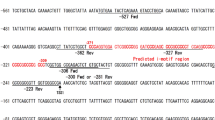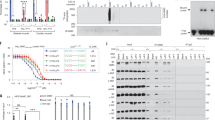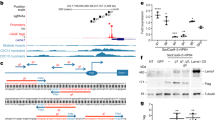Abstract
Up-regulation of utrophin gene expression is recognized as a plausible therapeutic approach in the treatment of Duchenne muscular dystrophy (DMD). We have designed and engineered new zinc finger-based transcription factors capable of binding and activating transcription from the promoter of the dystrophin-related gene, utrophin. Using the recognition ‘code’ that proposes specific rules between zinc finger primary structure and potential DNA binding sites, we engineered a new gene named ‘Jazz’ that encodes for a three-zinc finger peptide. Jazz belongs to the Cys2-His2 zinc finger type and was engineered to target the nine base pair DNA sequence: 5′-GCT-GCT-GCG-3′, present in the promoter region of both the human and mouse utrophin gene. The entire zinc finger α-helix region, containing the amino acid positions that are crucial for DNA binding, was specifically chosen on the basis of the contacts more frequently represented in the available list of the ‘code’. Here we demonstrate that Jazz protein binds specifically to the double-stranded DNA target, with a dissociation constant of about 32 nM. Band shift and super-shift experiments confirmed the high affinity and specificity of Jazz protein for its DNA target. Moreover, we show that chimeric proteins, named Gal4-Jazz and Sp1-Jazz, are able to drive the transcription of a test gene from the human utrophin promoter.
This is a preview of subscription content, access via your institution
Access options
Subscribe to this journal
Receive 12 print issues and online access
$259.00 per year
only $21.58 per issue
Buy this article
- Purchase on Springer Link
- Instant access to full article PDF
Prices may be subject to local taxes which are calculated during checkout






Similar content being viewed by others
References
Choo Y, Sánchez-García I, Klug A . In vivo repression by a site-specific DNA-binding protein designed against an oncogenic sequence Nature 1994 372: 642–645
Pomerantz JL, Sharp PA, Pabo CO . Structure-based design of transcription factors Science 1995 267: 93–96
Wu H, Yang WP, Barbas III CF . Building zinc fingers by selection: toward a therapeutic application Proc Natl Acad Sci USA 1995 92: 344–348
Bryson JW et al. Protein design: a hierarchic approach Science 1995 270: 935–940
Corbi N, Perez M, Maione R, Passananti C . Synthesis of a new zinc finger peptide; comparison of its ‘code’ deduced and ‘CASTing’ derived binding sites FEBS Lett 1997 417: 71–74
Kim JS, Pabo CO . Transcriptional repression by zinc finger peptides. Exploring the potential for applications in gene therapy J Biol Chem 1997 272: 29795–29800
Corbi N, Libri V, Fanciulli M, Passananti C . Binding properties of the artificial zinc fingers coding gene Sint1 Biochem Biophys Res Commun 1998 253: 686–692
Desjarlais JR, Berg JM . Length-encoded multiplex binding site determination: application to zinc finger proteins Proc Natl Acad Sci USA 1994 91: 11099–11103
Choo Y, Klug A . Selection of DNA binding sites for zinc fingers using rationally randomized DNA reveals coded interactions Proc Natl Acad Sci USA 1994 91: 11168–11172
Rebar EJ, Pabo CO . Zinc finger phage: affinity selection of fingers with new DNA-binding specificities Science 1994 263: 671–674
Choo Y, Klug A . Physical basis of a protein-DNA recognition code Curr Opin Struct Biol 1997 7: 117–125
Gogos JA et al. Recognition of diverse sequences by class I zinc fingers: asymmetries and indirect effects on specificity in the interaction between CF2II and A+T-rich elements Proc Natl Acad Sci USA 1996 93: 2159–2164
Kim JS et al. Design of TATA box-binding protein/zinc finger fusions for targeted regulation of gene expression Proc Natl Acad Sci USA 1997 94: 3616–3620
Jamieson AC, Wang H, Kim SH . A zinc finger directory for high-affinity DNA recognition Proc Natl Acad Sci USA 1996 93: 12834–12839
Greisman AH, Pabo CO . A general strategy for selecting high-affinity zinc finger proteins for diverse DNA target sites Science 1997 275: 657–661
Isalan M, Choo Y, Klug A . Synergy between adjacent zinc fingers in sequence-specific DNA recognition Proc Natl Acad Sci USA 1997 94: 5617–5621
Choo Y . End effects in DNA recognition by zinc finger arrays Nucleic Acid Res 1998 26: 554–557
Mandel-Gutfreund Y, Margalit H . Quantitative parameters for amino acid-base interaction: implications for prediction of protein-DNA binding sites Nucleic Acid Res 1998 26: 2306–2312
Liu Q, Segal DJ, Ghiara JB, Barbas III CF . Design of polydactyl zinc-finger proteins for unique addressing within complex genomes Proc Natl Acad Sci USA 1997 94: 5525–5530
Kamiuchi T et al. Artificial nine zinc-finger peptide with 30 base pair binding sites Biochemistry 1998 37: 13827–13834
Love D et al. Dystrophin and dystrophin-related proteins: a review of protein and RNA studies Neuromusc Disord 1993 3: 5–21
Pons F et al. Dystrophin and dystrophin-related protein (utrophin) distribution in normal and dystrophin-deficient skeletal muscles Neuromusc Disord 1993 3: 507–514
Pearce M et al. The utrophin and dystrophin genes share similarities in genomic structure Hum Molec Genet 1993 2: 1765–1772
Winder SJ, Gibson TJ, Kendrick-Jones J . Dystrophin and utrophin: the missing links! FEBS Lett 1995 369: 27–33
Winder SJ . Structure-function relationships in dystrophin and utrophin Biochem Soc Trans 1996 24: 497–501
Winder SJ . The membrane–cytoskeleton interface: the role of dystrophin and utrophin J Musc Res Cell Motil 1997 18: 617–629
Gramolini AO, Jasmin BJ . Duchenne muscular dystrophy and the neuromuscular junction: the utrophin link BioEssays 1997 19: 747–750
Tinsley JM, Davies KE . Utrophin: a potential replacement for dystrophin? Neuromusc Disord 1993 3: 537–539
Tinsley JM et al. Amelioration of the dystrophic phenotype of mdx mice using a truncated utrophin transgene Nature 1996 384: 349–353
Deconinck N et al. Expression of truncated utrophin leads to major functional improvements in dystrophin-deficient muscles of mice Nature Med 1997 3: 1216–1221
Rafael JA et al. Skeletal muscle-specific expression of a utrophin transgene rescues utrophin-dystrophin deficient mice Nat Genet 1998 19: 79–82
Dennis CL, Tinsley JM, Deconinck AE, Davies KE . Molecular and functional analysis of the utrophin promoter Nucleic Acid Res 1996 24: 1646–1652
Kadonaga JT, Carner KR, Masiarz FR, Tjian R . Isolation of cDNA encoding transcription factor Sp1 and functional analysis of the DNA binding domain Cell 1987 51: 1079–1090
Christy BC, Lau LF, Nathans D . A gene activated in mouse 3T3 cells by serum growth factors encodes a protein with ‘zinc finger’ sequences Proc Natl Acad Sci USA 1988 85: 7857–7861
Choo Y, Klug A . Toward a code for the interactions of zinc fingers with DNA: selection of randomized fingers displayed on phage Proc Natl Acad Sci USA 1994 91: 11163–11167
Sadowski I . Uses for GAL4 expression in mammalian cells Genet Eng (NY) 1995 17: 119–148
Choo Y et al. Promoter-specific activation of gene expression directed by bacteriophage-selected zinc fingers J Mol Biol 1997 273: 525–532
Beerli RR, Segal DJ, Dreier B, Barbas III CF . Toward controlling gene expression at will: specific regulation of the erbB-2/HER-2 promoter by using polydactyl zinc finger proteins constructed from modular building blocks Proc Natl Acad Sci USA 1998 95: 14628–14633
Erlod-Ericson M, Pabo CO . Binding studies with mutants of zif268. Contribution of individual side chains to binding affinity and specificity in the zif268 zinc finger-DNA complex J Biol Chem 1999 274: 19281–19285
Wolfe SA, Greisman HA, Ramm EI, Pabo CO . Analysis of zinc fingers optimized via phage display: evaluating the utility of a recognition code J Mol Biol 1999 285: 1917–1934
Berg JM . Sp1 and the subfamily of zinc finger proteins with guanine-rich binding sites Proc Natl Acad Sci USA 1992 89: 11109–11110
Biesiada E, Hamamori Y, Kedes L, Sartorelli V . Myogenic basic helix–loop–helix proteins and Sp1 interact as components of a multiprotein transcriptional complex required for activity of the human cardiac alpha-actin promoter Mol Cell Biol 1999 19: 2577–2584
Wadzinski BE et al. NH2-terminal modification of the phosphatase 2A catalytic subunit allows functional expression in mammalian cells J Biol Chem 1992 267: 16883–16888
Smith DB, Johnson KS . Single-step purification of polypeptides expressed in Escherichia coli as fusions with glutathione S-transferase Gene 1988 67: 31–40
Acknowledgements
We acknowledge Dr Lucia Monaco for critical discussion. We thank Mr Giuseppe Santarelli for technical assistance. This work was supported by TELETHON (project A63) and by the MRC (UK).
Author information
Authors and Affiliations
Rights and permissions
About this article
Cite this article
Corbi, N., Libri, V., Fanciulli, M. et al. The artificial zinc finger coding gene ‘Jazz’ binds the utrophin promoter and activates transcription. Gene Ther 7, 1076–1083 (2000). https://doi.org/10.1038/sj.gt.3301204
Received:
Accepted:
Published:
Issue Date:
DOI: https://doi.org/10.1038/sj.gt.3301204
Keywords
This article is cited by
-
ZFP226 is a novel artificial transcription factor for selective activation of tumor suppressor KIBRA
Scientific Reports (2018)
-
Genome engineering: a new approach to gene therapy for neuromuscular disorders
Nature Reviews Neurology (2017)
-
UtroUp is a novel six zinc finger artificial transcription factor that recognises 18 base pairs of the utrophin promoter and efficiently drives utrophin upregulation
BMC Molecular Biology (2013)
-
Drug-inducible and simultaneous regulation of endogenous genes by single-chain nuclear receptor-based zinc-finger transcription factor gene switches
Gene Therapy (2008)
-
Targeted gene insertion for molecular medicine
Journal of Molecular Medicine (2008)



